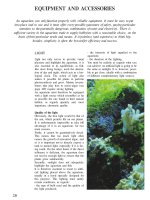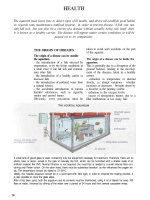The Complete Aquarium Guide - Part 3
Bạn đang xem bản rút gọn của tài liệu. Xem và tải ngay bản đầy đủ của tài liệu tại đây (1.15 MB, 15 trang )
ZANCLIDAE
SIGANIDAE
T
hese are distinguished by spiny spokes which secrete a venomous
substance. A prick is painful for an aquarist, although not as much
as one caused by a lionfish (but it is still advisable to consult a
doctor). These small-mouthed fish are herbivorous.
Siganus
Several of these species are commercially available. The
peaceful rabbitfish graze algae in the decor but also
accept small pieces of animal food. When they are
frightened they take refuge in the
hiding places that are
indispensable for these
fishes. Size: 20 cm. •
• Lo vulpinus
Hardy and easy to acclimatize, the
foxface feeds on small, live prey and
vegetable material. It will accept mussel
pieces but what it really relishes is ground
spinach. It is placid but active, and needs
room to swim, along with somewhere to
hide. Size: 20 cm.
ZANCLIDAE
T
he Zanchlids have a very compact body: one of the spokes of the dorsal fin is extended in a fine
filament. Considered fragile and delicate, they feed on small, live prey and can sometimes attack
invertebrates (corals, worms). Even if their form suggests otherwise, they are closely related to the
Acanthurids, although, unlike these, they do not have a spine on the caudal peduncle. These fish are
sensitive to chemical treatments and can die
suddenly, without any apparent reason. In
their native habitat (the Indo-Pacific region),
they are respected, and even sometimes
venerated, by local fishermen, who often
return them to the sea.
Zanclus canescens
The Moorish idol normally feeds
on algae and sponges. In captivity it
must be given a wide range of food
so that it can make its own choice.
It does not tolerate the presence of
other Zanclids. Z. cornutus is
considered a closely related species,
but is distinguished by the absence
of small spines in front of the eyes.
Size: 25 cm.
149
MARINE FISH
ACANTHURIDAE (TANGS)
N
ative to the tropical waters of the Indian and Pacific oceans, the tangs are less common in the Atlantic
ocean. An upright spine on the caudal peduncle has earned them the alternative name of surgeonfish,
as this spine resembles a scalpel. It plays a defensive role and can represent a danger for the aquarist.
Despite their squat bodies, which seem to have been squashed sideways, they are good swimmers, and
they live in groups in a natural setting. They feed on algae and small prey which fit into their mouths.
These fish are active and require a tank of at least 300 liters, with only one tang, because in such a limited
space they do not get along with each other. It is also advisable not to put any invertebrates into the
aquarium. Tangs feed on brine shrimps or other live prey, but they also require a vegetable complement.
The water must be well filtered and stirred, with fairly bright lighting,
to favor the growth of algae.
The young are easier to acclimatize. Their reproduction, which,
in their natural environment, seems to be connected with the
lunar cycle, has never been observed in an aquarium.
Acanthurus achilles
A very delicate species to keep, the Achilles tang appreciates
partial (but small) changes of water on a regular basis. It accepts
vegetable foodstuffs and small animal prey. Size: 15-18 cm. •
• Acanthurus japonicus
The powder brown tang is a good swimmer. It keenly grazes the
algae on the decor, but also accepts small prey. It is very delicate
to keep in captivity. Size: 18 cm.
Acanthurus lineatus
This is a fairly easy species to keep in captivity, if it is supplied with
vegetable foodstuffs. A good swimmer, the clown tang behaves
extremely aggressively towards other tangs. Size: 18-20 cm. •
Acanthurus leucosternon •
The powder blue tang appreciates hiding
places and changes of water. Difficult to
acclimatize, it can however accept commercial foodstuffs if they
are predominantly vegetable. Size: 15 cm.
150
ACANTHURIDAE
Acanthurus sohal
The sohal tang is one of the most beautiful of the Acanthurids. It
can accept artificial vegetable food, but it prefers to feed on brine
shrimps and ground mussels. Its territorial behavior sometimes
makes it aggressive. Size: 25 cm.
Naso brevirostris
Young longnose unicorn fish do not have a horn. A related
species, N. unicornis, only has a hump on its forehead. These two
species are vigorous swimmers and mainly feed on algae; the
adults are more carnivorous than the young. Size: 25-30 cm. •
• Naso lituratus
The smooth-headed unicorn fish is a relatively easy species to
keep. Although generally placid, they can become aggressive if
they are upset. The adults in this species have fine
extensions to the tips of the caudal fin, while the
juveniles have white patches. Size: 25 cm.
Paracanthurus hepatus •
The blue coloring of the young turns gray on their belly and back
once they reach adulthood. Somewhat unobtrusive, the hippo
tang likes having hiding places. Size: 18 cm
• Zebra so ma flavescens
The anal and dorsal fins of the zebrasomas are more developed
than those of other tangs. These timid species must be provided
.vith shelters. The coloring of the yellow tang varies according to
ts geographical origins. Size: 18 cm.
Zebrasoma veliferum
When the sailfin tang is in motion, this beautiful swimmer tucks
its fins along its body, although it does open them to "impress"
other members of the same species and to chase them off its
territory (the yellow tang does the same). Size: 30 cm. •
151
MARINE FISH
SCORPAENIDAE (LIONFISH)
L
ionfish are not only stunning to look at, but they can also
constitute a real danger for an aquarist: some of their spiny
spokes emit a venom similar to that of certain snakes. They are placid
and majestic fish, easy to keep in an aquarium of at least 300 liters.
The tank must be furnished with elaborate and convoluted decor,
complete with grottoes and overhangs: lionfish swim through them
flat or at an angle. Their large mouth is equal to their voracity: they devour live prey, often small fish (take
care with their roommates!). Nevertheless, these remain amongst the most deirable subjects for the
amateur aquarist and repay without any doubt any amount of trouble.
WHAT TO DO IF
YOU ARE STUNG
Consult a doctor immediately. The very
intense pain increases for 20 minutes,
reaches a peak, and gradually subsides
over a period of 4-24 hours. Bleed the
wound and immerse it in the hottest
water possible to partially inhibit
the action of the venom.
Obviously, the best idea is
to avoid getting stung;
take care when putting
your hand into the tank
and wear protective
gloves that are water-
impermeable.
Pterois volitans
The volitan lionfish is the one most often
found in the aquarium trade. It gets
accustomed to dead foodstuffs. The
membrane linking the spokes of the
pectoral fins runs to the rear end of their
body, which is not the case with the other
species of the Pterois genus, where the
rear is unencumbered.
Size: 35 cm
• Pterois antennata
The antenna lionfish has four dark bands
on its head. A close relative, P. sphex, has
less intense coloring. The latter is hard to
find in Europe, but is frequently imported
into the United States. Size: 20 cm.
Pterois radiata
Two white horizontal bands on the
caudal peduncle distinguish the
radiata lionfish from the other species.
Easy to keep, it gets
used to eating dead
prey. Size: 25 cm. •
Dendrochirus zebra
The dwarf lionfish does not grow longer than 15 cm, in contrast
to the Pterois. It is also distinguished by the absence of a
membrane between the spokes of the pectoral fins.
Size: 15 cm.
152
BALISTIDAE
BALISTIDAE (TRIGGERS)
T
riggers live in reef areas where the water is in constant movement, so you must plan a large aquarium
for them (at least 400 liters) with highly agitated and well-oxygenated water. Their jaws and teeth
allow them to graze on coral, crabs, and mollusks. In captivity they accept animal food, such as small
mollusks (cockles, mussels), complete with their shells. They are fairly aggressive and must be kept singly,
away from small fish and invertebrates. One of the distinguishing features of this family of marine fish is
its ability to stick out the first spoke of its dorsal fin, and then block it with the second one (explaining
their alternative name of crossbowmen).
• Balistoides conspicillum
The clown trigger is not only voracious -
it is also fast, usually reaching any food
before other fish. It is not slow to
rearrange the decor, either, although it
is easy to domesticate. However, it is best
to acclimatize it before it measures more
than 10 cm. Size: 25 cm.
• Balistapus undulatus
The undulated trigger fish is so resistant that it can survive for
over 10 years in an aquarium. It is easy to acclimatize and keep,
although it is prone to knocking over bits of decor. Size: 20 cm.
Balistes vetula
The queen trigger fish, native to the tropical Atlantic - the
others come from the Indo-Pacific region - is one of the most
placid. It is easy to acclimatize and grows quickly - sometimes up
to 50 cm. Size: 30-50 cm.
• Rhinecanthus aculeatus
Its common name, the Picasso trigger fish, comes from its
distinctive coloring. It defends its territory fiercely. Some related
species (R. asasi, R. rectangulus, R. verrucosus) are sometimes
commercially available, often under the same name. Size: 20 cm.
153
MARINE FISH
Odonus niger
The blue trigger fish can live for more than 10 years.
If you have a couple, reproduction may be possible in
a very large aquarium, in a nest dug into the sand.
Size: 20 cm. •
Pseudobalistes fuscus
The coloring of juveniles is paler than that
of adults. The blue line trigger is fairly
aggressive but can get to know its owner.
It sometimes looks for its food by
"spitting" water to lift up the sand.
Size: 35 cm.
Xanthichthys auromarginatus •
The magnificent blue throat trigger requires a large
tank, with shelters where it can take refuge at night. It is
aggressive towards both fish smaller than itself and
members of its own species. Size: 30 cm.
HAEMULIDAE - NEMIPTERIDAE
T
he Haemulids (grunts or pork fish) make sounds by
grinding their teeth, with the swim bladder acting as
a resonator. Rarely found in aquariums, they are
nevertheless robust.
The Nemipterids live near reefs and are vigorous free-
swimmers. They feed on small prey captured on their
journeys or in the sediment.
Anisotremus
virginicus (Haemulidae)
The pork fish lives in schools
when it is young. The adults
gradually become loners as
they grow older, and their
coloring becomes brighter. In
captivity, they can be fed
small animal prey, dead or
alive. Size: 30 cm.
• Symphorichthys
spilurus (Nemipterid)
The large long fin or blue and
gold snapper requires a lot of
water to be able to move around
freely. It prefers to live in calm
areas and accepts a wide range
of food. This brightly colored fish
is rarely found in the aquarium
trade. Size: 30 cm.









